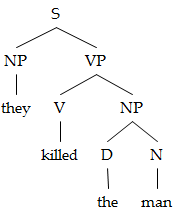Syntax
In Linguistics, syntax is "the study of the principles and processes by which sentences are constructed in particular languages"[1]. It assumes that:
- natural language sentences can be broken down into components (the so-called syntactic constituents);
- the resulting structure (i.e., the relations between syntactic constituents) is hierarchical (a tree-like structure) rather than a simple list; and
- the structure can be predicted by rules (i.e., the structure is regular), which consist the grammar of the language.
For instance, the sentence:
they killed the man
is more productively represented as (1) than (2)

|
[they][ ][killed][ ][the][ ][man] | |
| (1) | (2) |
Immediate Constituent Analysis
In linguistics, immediate constituent analysis or IC analysis is a method of sentence analysis that was first mentioned by Leonard Bloomfield[2] and developed further by Rulon Wells[3]. The process reached a full blown strategy for analyzing sentence structure in the early works of Noam Chomsky[1]. IC-analysis divides up a sentence into major parts or immediate constituents, and these constituents are in turn divided into further immediate constituents. The process continues until irreducible constituents are reached, i.e., until each constituent consists of only a word or a meaningful part of a word. The end result of IC-analysis is often presented in a visual diagrammatic form that reveals the hierarchical immediate constituent structure of the sentence at hand. These diagrams are usually trees. For example:
This tree illustrates the manner in which the entire sentence is divided first into the two immediate constituents; these two constituents are further divided into the immediate constituents; and so on. An important aspect of IC-analysis is that each individual word is a constituent by definition. The process of IC-analysis always ends when the smallest constituents are reached, which are often words (although the analysis can also be extended into the words to acknowledge the manner in which words are structured).